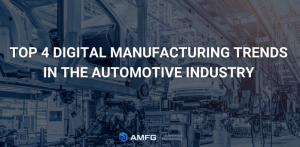[Updated in 2020]
Design flexibility, material efficiency and viable low-volume production are just some of the reasons why companies have increasingly turned to additive manufacturing (AM). But to make the most of AM in production, there are still some issues to tackle.
Below, we’re looking at some of the most pressing challenges the technology needs to overcome to accelerate its adoption:
Technological challenges
1. Slow production speeds
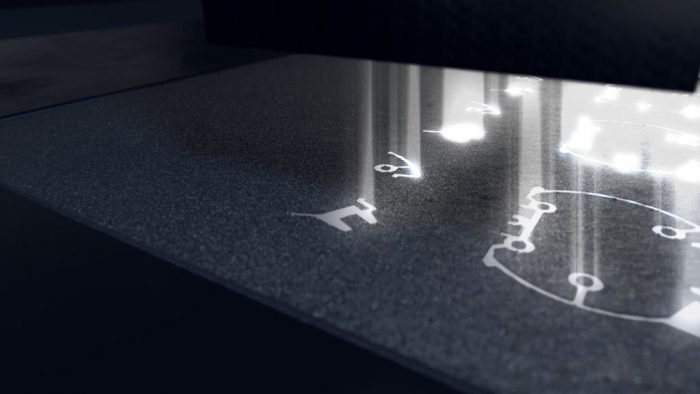
EOS’s LaserProFusion technology will be equipped with up to
a million of diode lasers to enable faster SLS 3D printing [Image credit: EOS]
No one would argue that speed matters, especially if the goal is large-scale production. However, many current industrial 3D printers still lag behind traditional mechanised equipment in terms of speed and efficiency.
This, particularly, is an obstacle for adoption in industries driven by mass serial production, such as automotive and consumer goods. In these industries, products need to be manufactured and delivered in as short a timeframe as possible, in order to maintain production efficiency.
“The final part is the throughput or the speed of the machines. [Automotive] production volumes are considerably different from the volumes of aerospace or medical. So we have to look at systems that are capable of producing parts in minutes or seconds as opposed to days and hours. Anything that we can do to push the technology into faster build speeds is definitely what will help us as well.”
Harold Sears, Technical Leader of Additive Manufacturing Technologies at Ford
High-speed AM has been an area of robust development and investment in recent years.
Most 3D printer manufacturers, targeting production applications, are looking for ways to make 3D printing faster. Some have developed modular systems that can help increase throughput, while others are working to further improve the technology behind their existing machines.
For example, German hardware manufacturer, EOS, is developing its Laser Pro Fusion technology, with an aim to increase the throughput in Selective Laser Sintering (SLS) technology. While current SLS systems use one or two CO2 lasers to fuse polymer powder together, the new 3D printer will be equipped with up to 1 million diode lasers, which could significantly accelerate the printing time.
There have also been some notable developments on the metal 3D printing side. Australian Aurora Labs’ Multilevel Concurrent Printing (MCP™) technology is one example. With this powder bed fusion process, Aurora Labs is looking to enable metal 3D printing at much faster speeds.
Unlike traditional powder bed technologies, that print one layer at a time, MCP prints multiple layers simultaneously in a single pass. At Formnext 2018, the company reported that it was able to print around 30 layers at a time, with the goal to increase this to 100 layers over the next 12 months.
Recently, the company has reported that its PMP1 3D printer can reach a print speed of 350 kg/day. Aurora Labs says this result indicates a 2000 per cent speed improvement compared to the speed reported last year.
Increasing production speed is no mean feat and requires substantial technological innovation. As of 2019, both EOS’ and Aurora Labs’ technologies are still in the development stage, meaning, it will take time to prove their production speed claims.
That said, we are confident that 3D printing will ultimately get there, as progress continues.
2. Materials development and inconsistencies in material properties
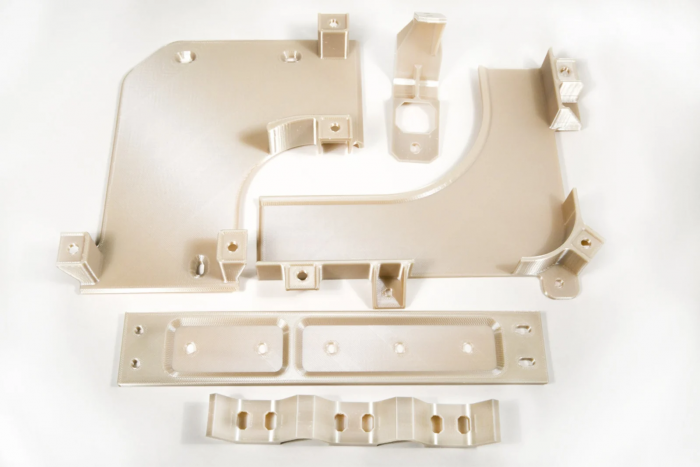
Aircraft parts 3D-printed using Stratasys’ ULTEM 9085 [Image credit: Stratasys]
“The additive manufacturing industry definitely needs solutions to more materials. 3D printing is theoretically capable of producing parts of high complexity and functionality, whether it’s mechanical, biological, electrical. But making that happen comes down to having enough material options.”
Simon Fried, Co-founder of Nano Dimension
The availability of suitable materials is another challenge for the 3D printing industry. When compared to traditional manufacturing processes, which have undergone decades of materials development, 3D printing’s own material development has just begun.
In the early years of 3D printing, when the industry’s focus was on prototyping, much less emphasis was put on material properties. However, with the technology transforming into a production solution, the material development process has accelerated tremendously.
A particularly exciting trend is the advancements in high-performance 3D printing polymer and composite materials. Large chemical companies like Arkema, BASF and DuPont are developing carbon-reinforced polymers, which offer strength sometimes comparable to metals.
A manufacturer of composite 3D printing technologies, Markforged, is also advancing this area and has developed several new materials. The most recently introduced is the Onyx FR, the first flame-retardant composite material.
On the metal side, material development takes longer, sometimes a few years, but the advancements are also ongoing.
While the availability of materials is increasing, there are still a lot of inconsistencies in the properties of the 3D printable materials. Currently, the industry lacks a solid database of materials with proven printing parameters and defined specifications. As a result, it becomes challenging to achieve a consistent and repeatable 3D printing process.
This means that most manufacturers will remain reluctant to use the technology, until they can ensure that material properties meet the industry’s predefined and accepted norms and standards.
The only way forward is the development of an AM material database with information on mechanical and thermal properties and specifications for successful printing.
The 3D printing industry is working towards achieving this goal. Standards developing organisations, like ISO and ASTM, have issued a few specifications on metal powders like nickel, titanium and stainless steel.
At the same time, other bodies build out a database of materials and process information for AM. For example, America Makes in collaboration with Stratasys and National Institute for Aviation Research (NIAR) released a database of material properties for ULTEM™ 9085 Type I used in Fused Deposition Modeling (FDM) earlier this year.
The establishment of such a database will help to further the use of the certified polymer material for aircraft interior components.
Ultimately, developments like this one will be key to ensuring that AM materials can meet manufacturers’ expectations for performance and reliability.
3. Manual post-processing
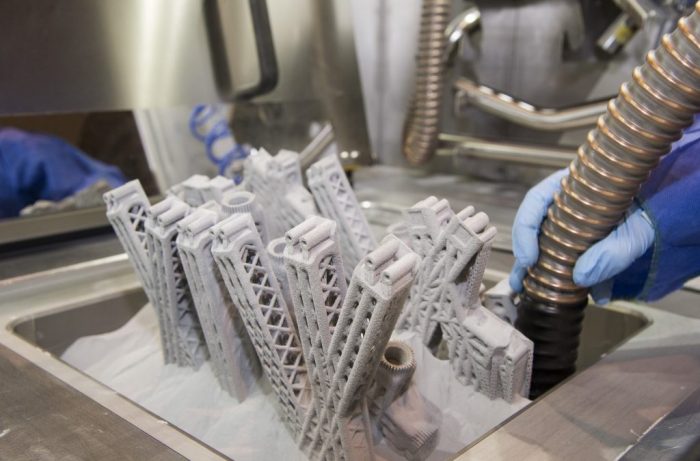
Manual powder removal [Image credit: Airbus]
The reality of 3D printing is that virtually all parts coming out of a 3D printer will require some type of post-processing to improve the mechanical properties, accuracy and aesthetics of a part.
This is not a big issue when using 3D printing for prototyping. However, as the technology is transitioning to an end-part manufacturing process, scaling and automating, post-processing, has become one of the key bottlenecks to establishing AM production lines.
“With metal AM, many steps are involved to ensure quality. This includes properly removing the powder and going through a stress relief heating cycle so that the parts do not warp and distort from the heat residual stress built up in the parts when they are removed from the build plate.
A lot of time is often required to cut and grind away the support structures. Other steps include CNC machining and other finishing work, as well as hot isostatic pressing, which helps to ensure that the part does not contain any porosity.”
Terry Wohlers, Founder and President of Wohlers Associates
The majority of post-processing operations Terry Wohlers describes above are still heavily manual processes, requiring skilled operators to perform key tasks.
It might be cost-effective to use human labour to finish a prototype or even a couple of dozen parts. However, when producing hundreds or even thousands of 3D-printed parts, the need for post-processing automation becomes extremely acute.
“Automated solutions will remove one of the biggest problems right now, which is allowing increased throughput with consistent output of the post-printing function.”
Jeff Mize, CEO of PostProcess Technologies
Currently, there are only a few AM-specific solutions which help to automate post-processing operations, like DyeMansion’s cleaning machines, AMT’s surface smoothing solutions and PostProcess Technologies’ support removal and surface finishing systems. Admittedly, these systems are designed primarily for polymer 3D-printed parts.
When it comes to metal 3D printing, post-processing technologies, used for traditionally manufactured parts, are currently being adapted for 3D-printed components.
To further automate these technologies, companies are now also beginning to implement robotic solutions to eliminate operations like material switchovers and part handling. For example, 3D printer manufacturer, Digital Metal, launched a fully automated production concept last year.
According to this concept, a robot will handle most of the process steps, such as feeding the printer with build boxes and then removing them for post-processing. The goal is to eliminate all manual work to facilitate continuous, high-volume production.
While such developments are encouraging, the pace of innovation in this area is sluggish. However, the number of advanced post-processing solutions will surely be increasing to match the ever-growing AM production volumes.
Software challenges
4. Limited capabilities in data preparation and design

“Design and data preparation are still a bottleneck in this industry while the emphasis is put on higher productivity hardware systems, with intelligent software solutions being excluded from this equation.”
Yves Hagedorn, Managing Director at Aconity3D
While it may seem as though 3D printing is as simple as pressing a button, that isn’t remotely the case. For one thing, industrial 3D printing requires significant design preparation to get a model ready for printing.
The design process is complicated by the fact that for a long time, Computer-Aided Design (CAD) and Computer-Aided Engineering software was largely not optimised for the requirements of 3D printing.
For example, it can be difficult to use traditional CAD software to design components made with graded materials, create lattice structures or model porosity.
Furthermore, the AM design workflow involves multiple steps, which are often bogged down by the need to use separate software solutions.
“We hear from many of our customers that they’re working with very disjointed workflows. They do the design process in a CAD tool, then they translate that to an STL file and import it into a build processor, like Netfabb. From there, it gets sent to the machine and the machine is collecting data on that. So you end up with these silos of data that are not well connected.”
Robert Yancey, Director of Manufacturing and Production Industry Strategy and Business Development at Autodesk
For example, in a typical scenario, a designer would create a solid model in their CAD system and then convert it into a triangulated model to perform printability checks, optimise the structure to reduce weight, add supports and run simulation analysis. All these steps will require different programs, different software environments and multiple file formats.
Then, imagine that you run a simulation and the results indicate a build failure, requiring you to alter the part orientation or support structures to prevent it. As a result, you’ll have to go back through all the steps and programs to change some parameters and make the model printable.
This need to transfer AM design data through multiple software solutions results in a time-intensive and error-prone design process.
The industry is trying to ease the burden of 3D model preparation in multiple ways. For example, software companies, like PTC, Autodesk and Dassault Systèmes, are melding specific 3D print functionality into their CAD programs.
For example, PTC is offering its Creo 6.0 software to enable design and print preparation in one environment. At the end of 2018, PTC acquired generative design software company, Frustum. The company is now working to add generative design technology, which is often combined with 3D printing, to its CAD platform.
At the same time, 3D printer manufacturers develop their own software solutions to streamline 3D model preparation. Stratasys’ GrabCAD and 3D Systems’ 3DXpert are just two examples of the software developed to eliminate or minimise the need for multiple data transfer and conversions.
Although great progress is being made on the AM design and print preparation front, there’s still room for development. Providing the designers with the ability to modify 3D models within the CAD environment and quickly iterating them without cumbersome data conversion, will be key to making the design preparation challenges a thing of the past.
Quality assurance challenges
5. Part-to-part variation

In-process monitoring could be a solution to a part-to-part variation issue [Image credit: Aconity3D]
“Another big thing that the industry needs to address to be more widely accepted is the part-to-part variation […] The reason for that is that the consistency of the material that comes out of the system is not necessarily what you want it to be. You have to design for the weakest part you might get, which means you’re not fully leveraging some of the capabilities of AM.”
Zachary Murphree, VP of Technology Partnerships at VELO3D
Traditional CNC machining, injection moulding or casting are well-understood manufacturing processes. 3D printing, on the other hand, offers a new approach to manufacturing parts. In addition to new opportunities, the technology also has new flaws not seen in traditional manufacturing, which can lead to variations in part quality from build to build.
This is particularly the case with metal 3D printing. For example, some of the flaws unique to metal AM can include powder trapped inside a part, microcracks and the lack of fusion.
One of the key sources of variations in part quality is material chemistry. Safety-critical applications, such as aircraft parts or medical devices, require a material to have the right morphology (particle size and shape) and be 100% free of contamination.
Impurities, caused by improper storage or handling, or questionable quality of the feedstock, can alter the properties of the final part, which could in turn, lead to a failed print.
Ensuring the quality of the material requires standardised test methods and tools, which the industry is largely lacking. To overcome these issues, AM users are partnering with trusted testing laboratories or, if they have enough resources, developing the necessary expertise in-house.
Another challenge impacting part variability lies in the lack of advanced process control in 3D printers. To minimise part variation, 3D printers need to shift from an open-loop to a closed-loop control system.
The latter refers to the ability of a 3D printing system to spot deviations during the printing process and automatically adjust the system to compensate for them. This is achieved by embedding sensors and cameras inside a 3D printer, which allows users to monitor the build in real-time.
Maintaining control over the build process, through the closed-loop control system, enables manufacturers to achieve consistent geometries, surface finishes and material properties that underpin quality.
“I think that’s the Holy Grail for AM because with in-process control you’re able to almost immediately react on deficiencies within your process.”
Yves Hagedorn, Managing Director at Aconity3D
However, in-process quality control, enabled by a closed-loop system, is still relatively new to AM technologies and presents a barrier to manufacturers to implement. As of 2019, only a small percentage of 3D printers available on the market are equipped with closed-loop control units.
That said, in-process control will become an absolute necessity, as 3D printing is moving to production floors. This ultimately means that the number of smarter systems is only set to increase in the near future.
6. Lack of industry-wide standards

ASTM/ISO framework for additive manufacturing
“It would be incredibly beneficial to all stakeholders and constituents if the industry had better standards overall, standards that are universally understood and accepted. With standards, companies can compare apples to apples and make intelligent decisions that can be implemented within a comprehensive ecosystem of suppliers, manufacturers and users.”
Avi Reichental, Founder of XponentialWorks
In manufacturing, standards are essential, as they outline the parameters that must be met to deliver a quality product. Raw materials, machines, equipment operators and engineers, suppliers and the manufacturing process itself, all need standards and a mechanism for qualifying/certifying against those standards to make parts with the required quality.
Although 3D printing has been around for more than 30 years, the manufacturing world began to recognise it as a production method only recently. For this reason, the industry has just begun to develop production-relevant and industry-wide standards.
“It’s great if you can make the part, but if you can’t prove that it’s a good part, it doesn’t do anybody any good. Standards are what get us across that line to be able to manufacture and sell parts and be able to use them in production.”
Matthew Donovan, Principal Engineer for Additive Manufacturing at Oerlikon
The lack of 3D printing standards remains one of the key bottlenecks slowing down its wider adoption.
However, there have been a lot of promising developments on this front. Some of the largest standards developing organisations, like ISO and ASTM International, have established committees dedicated to AM standards development. By 2018, the two organisations approved 28 standards, with many more to be issued in the next couple of years.
Standards development is also greatly bolstered by industry collaboration and partnerships. One example is a collaboration between Oerlikon and Boeing. Targeting AM use in aerospace and defence, the partnership is focused on standardising materials and processes for powder-based metal 3D printing of structural titanium components.
Perhaps the most powerful collaboration involves the launch of Additive Manufacturing Center of Excellence (AM CoE) last year. The new facility, founded by ASTM International in collaboration with Auburn University, NASA, EWI and the UK-based Manufacturing Technology Centre (MTC), is focused on bridging R&D and standardisation to fill key industry gaps.
In September, ASTM International announced the second round of funding with the goal to support AM CoE’s standardisation projects. Each of the nine projects contributes towards different standard gaps in design, feedstock, process, post-processing, testing and qualification.
While standards development is a time-intensive process, the recent progress suggests that it will eventually yield results, enabling manufacturers to develop and implement AM applications faster and more easily.
Workforce challenges
7. Lack of understanding and expertise in AM
“[The] workforce element is really critical right now. There are not enough engineers, managers, executives who truly understand the technology well enough to work and develop a strategy to get what they need to get out of it.”
John Barnes, Founder of The Barnes Group Advisors
A lack of thorough understanding of the capabilities of 3D printing technologies can create many barriers to entry. Currently, there is still a knowledge gap in terms of what 3D printing technologies are, what their capabilities are and how they can be used. As a result, businesses, which could benefit from the technology, are unwilling to adopt it, as they struggle to develop a business case or use case for 3D printing.
“Companies see the opportunity for additive manufacturing but often don’t have enough expertise with the technology to really understand how to quickly move into production.”
Robert Yancey, Director of Manufacturing and Production Industry Strategy and Business Development at Autodesk
“The majority of our customers still don’t really understand the technology well, and don’t know how to use or when to use it. Often they think that you can do anything with a 3D printer and that 3D printing can replace other technologies, which is not true.”
Alessio Lorusso, CEO of Roboze
Understanding the difference between traditional and additive technologies is another challenge. 3D printing has its own design and manufacturing rules, which dictate the feasibility of producing a part with this technology.
This means that the technology can be counterintuitive for engineers that have been trained to design for traditional manufacturing and will require a steep learning curve to master it.
“You have a mindset of looking at traditional manufacturing techniques, and we were educated with traditional manufacturing techniques. People often start with parts that were made using traditional way and want to force-fit additive to that part, but that doesn’t always match.”
Wiener Mondesir, Co-Founder and Chief Technology Officer of Arevo
Fortunately, a lot of companies are now focusing on bridging this knowledge gap. Some are launching online and on-site courses to help engineers develop a 3D printing skill set, while others establish centres of excellence to deepen their expertise in AM.
Turning to AM consultancies is another great way to foster knowledge transfer, in addition to attending AM conferences.
Ultimately, only by learning about the capabilities and limitations of 3D printing, will companies be able to use this knowledge to develop successful applications for the technology.
“There is the question of being thoughtful about which technologies best fit which applications. It’s important to be clear about the problem you’re trying to solve and choose the right tool to solve that problem.”
Duncan McCallum, CEO of Digital Alloys
Financial challenges
8. Making the initial investment

Adopting AM does take time and effort. However, the greatest barrier to adoption may lie in substantial investment needed to put AM on the production floor.
Investment in AM is not only about buying the equipment. It’s more about investing in the AM ecosystem, which encompasses software, materials, employees training, post-processing equipment, certification and finally establishing a facility to accommodate all this.
The capital and resources required to put this puzzle together, are sometimes so enormous that an organisation is unwilling or even unable to invest in AM.
“The cost of equipment needs to come down to unlock the technology for broader markets.”
Armin Wiedenegger, Strategy & Business Development for Additive Manufacturing at voestalpine High Performance Metals GmbH
However, there are companies making hardware more accessible. On the polymer side, a number of 3D printer manufacturers are developing industrial desktop 3D printers, which are easy to set up and use. Such systems typically cost much less than high-end 3D printers, which could easily run into hundreds of thousands of dollars.
For example, UK-based automotive manufacturing company, Dunlop Systems and Components, has integrated Markforged’s composite 3D printer, priced at around $15,000.
In less than nine months after installing the 3D printer, the company found multiple uses for the technology, which could save it up to £40,000 per year. The company also says that it had the payback within six months, which is quite impressive.
There are similar developments on the metal side, with companies like Desktop Metal, Markforged and Xact Metal, offering entry-level metal AM systems. Metal 3D printers of this kind are compact and cost up to $150,000, which is a fraction of the cost compared to larger metal 3D printers.
While investment in AM technology may be daunting, it often can be justified when considering the overall impact of the technology on the bottom line. That’s why it’s important to develop a business case before jumping in. In Dunlop’s case, for example, the company started by identifying a handful of quick wins that could reduce costs and generate clear financial payoffs in the short term.
When successful, the quick wins will attract attention and create a sense of momentum, eventually generating resources that can be invested in more ambitious, longer-term projects.
Workflow and integration challenges
9. Disjointed AM ecosystem

“The entire AM ecosystem is fragmented: there are a lot of little solutions and companies that you have to cobble together to create a workflow and end-to-end solution.”
Dave Conover, Chief Technologist of Additive Manufacturing at Ansys
For AM processes to scale at the industrial level, the AM value chain, which begins from conception to production and post-processing of the product, needs to become more consolidated.
Currently, the market is saturated with many different solutions, which ideally could be integrated to create a comprehensive offering, thereby simplifying the adoption of the technology.
As a result, companies looking to adopt AM are faced with the need to buy disparate solutions and then try to make them work together. This lack of integration in the AM value chain creates a lot of inefficiencies in the workflow.
Some companies are overcoming this challenge through collaboration. Many AM hardware manufacturers are teaming up with software providers to improve user experience.
One example includes the partnership between industrial desktop 3D printer developer, RIZE, and software company, Dassault Systèmes. With this partnership, Dassault’s SOLIDWORKS and RIZE will work together to enable seamless integration between SOLIDWORKS design software and RIZE printers.
Other companies are consolidating the AM ecosystem by expanding their roles along the value chain. For example, Henkel, a chemical manufacturer and formulation specialist, has developed a variety of offerings along the entire value chain.
These include producing custom-made material formulations, selling printers under the Loctite brand and reselling printing equipment manufactured by HP and Carbon. Henkel also offers services for printing and post-processing of parts.
“Creating ecosystems and collaborating can be a significant force multiplier to accelerating [3D printing] adoption even further.”
Avi Reichental, Founder of XponentialWorks
Ultimately, optimising the interconnection among all elements in the AM value chain will be key to creating a stronger industry.
10. A lack of digital infrastructure
To be able to use 3D printing in production, companies need the right digital infrastructure to manage their 3D printing operations efficiently.
Many companies are establishing such an infrastructure by using off-the-shelf IT solutions. In many cases, these solutions have been developed with the requirements of traditional manufacturing in mind and are often not optimised for 3D printing workflows.
To overcome this issue, the industry has been developing workflow management software specifically for 3D printing. Such software helps to manage the entire workflow, from request management, printability analysis and machine analytics to production scheduling, post-processing management and communicating with suppliers.
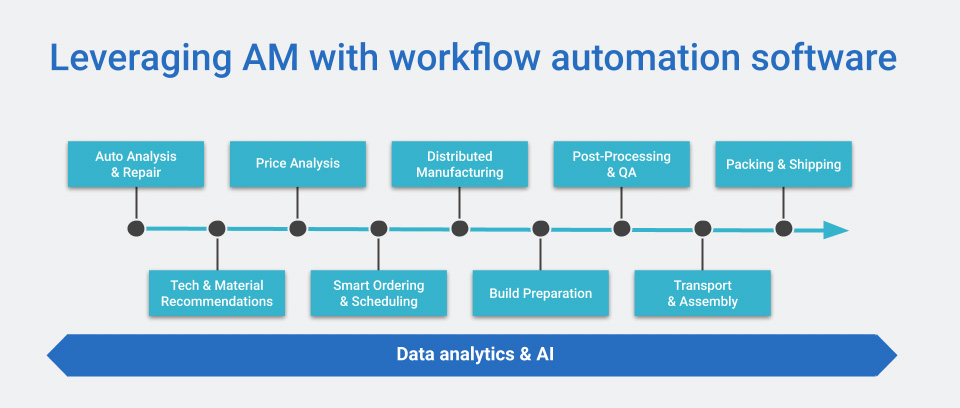
Leveraging additive manufacturing with workflow automation software
As a result, a company can have a centralised production planning and monitoring system, which enables it to track parts and view projects, allowing for greater traceability.
Workflow management software is fast becoming one of the key solutions needed to create the digital infrastructure for AM production. It makes day-to-day business processes more efficient, by coordinating tasks between people. Finally, it helps to synchronise data between systems, making the integration of AM into a digital manufacturing environment much simpler.
The evolving industry
As a young technology, 3D printing has many challenges, but the good thing is that the industry is eager to overcome them. Over the last decade, the industry has made a quantum leap forward by developing better and faster systems, creating more materials and automation solutions and expanding the list of approved standards.
Furthermore, we’ve seen a lot of effort made to bridge the knowledge gaps and foster a new generation of AM professionals. Finally, the industry itself is becoming more consolidated, as companies are looking to partner, in a bid to create comprehensive solutions.
All these activities are indicative of a thriving industry, which will continue to grow and evolve in the years to come.
Take a look at our previous Expert Roundup discussing the future of industrial 3D printing.
![You are currently viewing 10 of the Biggest Challenges in Scaling Additive Manufacturing for Production in 2020 [Expert Roundup]](https://global3dhub.com/wp-content/uploads/2021/01/10-challenges-in-scaling-additive-manufacturing-for-production-820x461-1.png)

